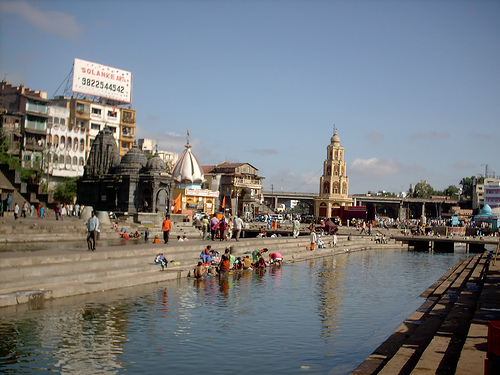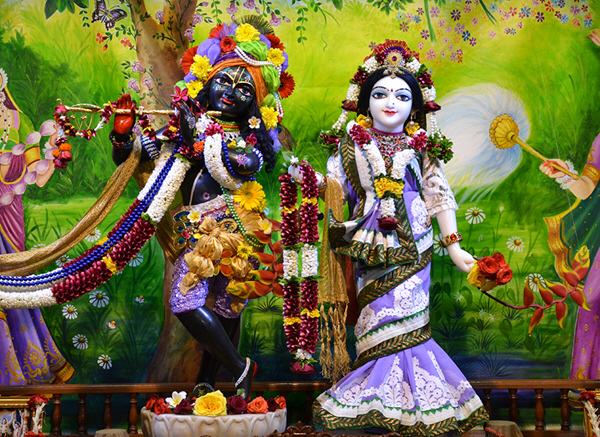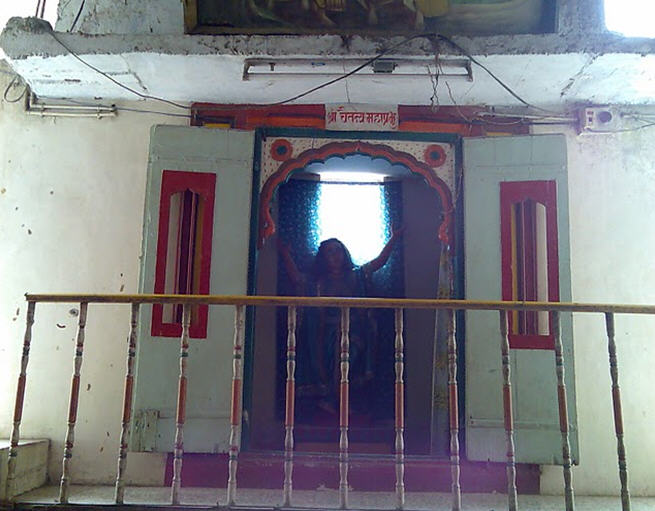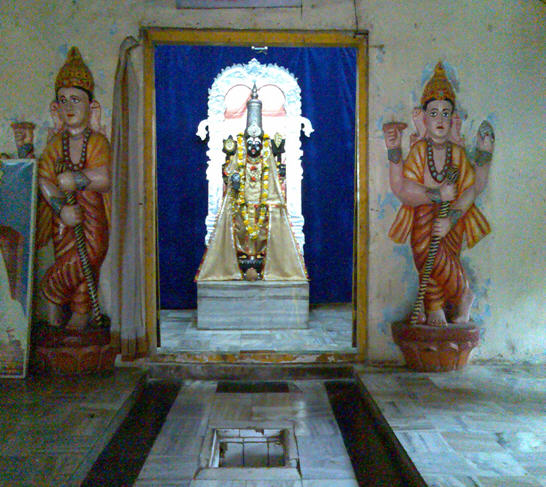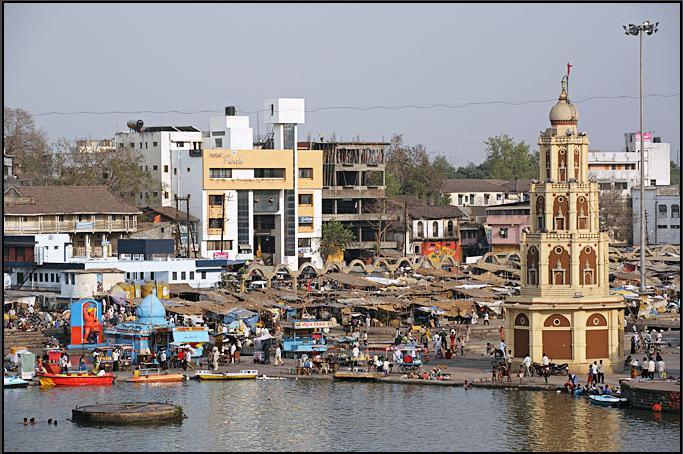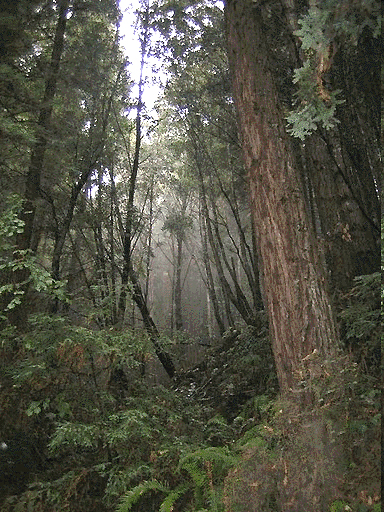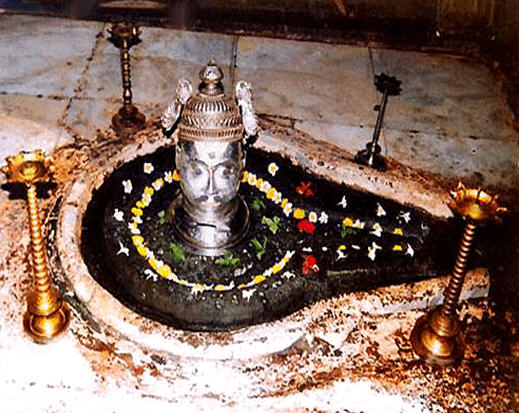 In the village of Trimbak, in the Nashik district of Mahrashtra, is the ancient temple of Trimbakeswar. Located 28 km. from the city of Nashik, Trimbakeswar is home to one of the twelve Jyotirlingas. While this temple is dedicated to Shiva, the presiding Deity here is Trimurti-linga, unlike the remaining eleven Jyotirlingas which all have Shiva as their predominant deity.
In the village of Trimbak, in the Nashik district of Mahrashtra, is the ancient temple of Trimbakeswar. Located 28 km. from the city of Nashik, Trimbakeswar is home to one of the twelve Jyotirlingas. While this temple is dedicated to Shiva, the presiding Deity here is Trimurti-linga, unlike the remaining eleven Jyotirlingas which all have Shiva as their predominant deity.
The Trimbakeswar Jyotirlinga is extraordinary in several ways. It embodies all three of the Trimurti together: Visnu, Brahma and Siva. The lingam is comprised of three small, thumb-like linga, each a member of the Trimurti. They are swayambhua, or self-manifesting. The three lingam are covered with a mask, usually of silver, which bears the faces of the Trimurti. On special occasions a gold mask is worn, and upon this, a jewelled crown is placed. The crown, covered in precious gems, is from the age of the Pandavas.
Trimbakeshwar is the only Jyotirlinga where the lingam sits in a depression on the floor, rather than projecting upwards, above it. Consequently, the trilingam in the sanctum is not worshipped with abhisheka in the usual way. Here, there is just the bottom part of the pounding stone (ukhali), which is a depression in which the three lingams sit. The Linga of Mahesha has a constant stream of natural water flowing over it. It is said that flames sometimes issue forth from the lingam depression, as well as a rumbling sound.
Sri Trimbakeswar is worshipped here with several offerings a day. During the evening puja, the Deity’s mask is removed and placed on a bed, in the hall of mirrors. Every Monday the silver mask is taken to the Kusavarta tank and given holy bath. A similar ritual takes place with the golden mask at each Shivratri, and on the full moon day in the month of Kartik.
Trimbakeshwar (Tryambakeshwar, Trambakeshwar) takes its name from ‘Trimbaka’, which means the Lord who has three eyes. This is a place of Tri-Sandhya Gayatri, the birthplace of Lord Ganesha, and the site of the first Nath of the Nath Sampradaya. Sinhastha Mahatmya mentions that Lord Rama made the yatra at Trimbakeshwar. Trimbakeshwar is also considered to be one of the holiest places to perform Shraddha. The Nirnaya Sindhu mentions Trimbakeshwar as the place where Sahyadri Mountain and Godavari River exist, purifying the entire earth planet.
Trimbakeswar Temple, which is constructed of black stone, is an imposing architectural monument. It is set against a backdrop of the Brahmagiri, a sacred hill from which three separate sources of the Godavari River emerge, flowing in three directions. The stream flowing east is called Godavari, the one flowing south is Vaitarna, and the third is called the west-flowing Ganga, which meets the Godavari near Chakra Tirth. The River Ahilya also meets the Godavari in front of the Trimbakeshwar Temple.
The sage Gautama had his ashrama in Trimbakeshwar, and during a 24-year period of drought, his pious credits caused Varuna to make the rains fall here. Indra became envious of the boon being enjoyed by Gautama, and caused even more rain to fall. Later, Gautama engaged in the episode of accidentally killing a cow, and in penance he performed austerities on the peak of the Brahmagiri. His prayers to Shiva resulted in the Ganges manifesting here, at Trimbak Tirth. Taking bath in this Kusavarta, Gautama was able to rid himself of the sin of cow killing. Kusavarta kund is considered to be the symbolic origin of the Godavari.
Kushavarta kund is a large area. The tank was built up with stone pavement and verandahs on all sides. There are temples at the four corners of the kund. On the southeast corner is the temple of Kedareshwar Mahadev, who in disguise of Kedarbhatta made Gautam bathe in the waters and gave him prayaschitta for the sin of killing a cow. To the southwest is Sakshi Vinayak, who is a witness to the yatra-vidhi of all pilgrims. To the northwest is Kusheshwar Mahadev, and to the northeast is the temple of Godavari.
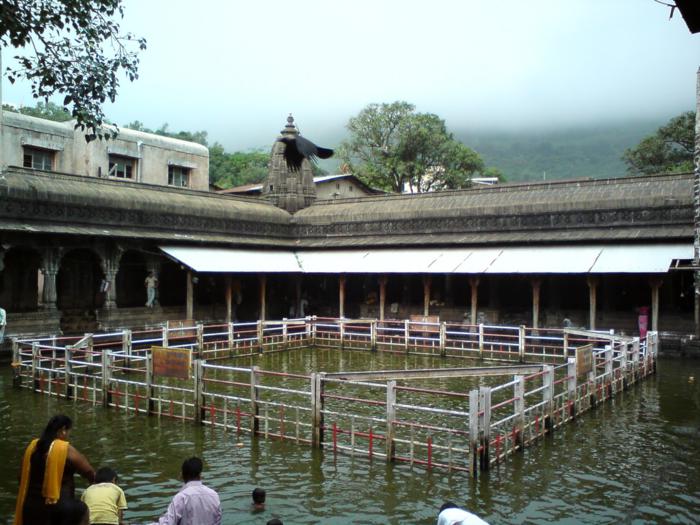
Kushavart Kund in Trimbakeshwar
The work of constructing the present main temple of Trimbakeshwar, built with black basalt, was begun by Shrimant Balaji Bajirao, the Nanasahib Peshawe, in 1755 and was completed in 1786, at a cost of 16 lacs. The Shiva deity installed in the temple at that time was decorated with a world famous gem – the Nassak diamond. The stone was appropriated by the British during the 3rd Anglo-Maratha war, and is currently in the hands of a U.S. businessman.
Trimbakeshwar Temple was built in the Nagara style. It is surrounded by a massive stone wall. A large Nandi sits in front of the temple, while a second beautiful marble Nandi is found inside. The garbhagriha is square internally, but is star-shaped externally. The porches have pillars and arches. The structure is replete with intricate sculptural work of scrolls, floral ornaments, and figures of various transcendental personalities and scenes.
The Triambaka-lingam is housed in the sanctum, crowned with a graceful tower, a large amalaka and a golden kalasha. In front of the garbagriha and the antarala there is a mandap with doors on four sides, three of which are covered with porches. The roof of the mandapam is a curvilinear slab, rising in steps.
Outside the temple is another area with linga and yoni installed, and separate pujas are done here. To the rear of the temple’s Gangamandir is a large caravansary, where Rama and Karpureshwar Mahadev are enthroned. There is also a separate temple of Ashwini Kumar in front of Gangamandir, temples of Jwareshwar Mahadev and Kanchaneshwar, and murtis of the Dasavatar and thirty-three other divine personalities. It is said that by Lord Shiva’s order, all the deities stay here in person during the period of Sinhastha Parva, coming to purify themselves.
Temple Locale and Events
There are two pradakshina routes around Trimbakeswar Kshetra. One circumambulates Brahmagiri, while the other goes around Hariharagiri.
There are a great many temples, shrines and theertham all in close proximity to the Trimbakeshwar temple complex. Seven km. away is Anjaneri mountain, the birthplace of Hanuman. The town has a large population of Brahmin households, so there are many gurukuls and learning centers. The place is also famous for the opulent religious rituals (vidhis) performed by brahmans, who have specialized in them. Narayan-Nagbali, Kalsarpa Shanti, Tripindi vidhi are done here. Narayan-Nagbalipuja is performed at Trimbakeshwar only, on certain days.
While popularly known as the Nashik Mela, Trimbakeshwar is actually the location of the Kumbha Mela. Held once every 12 years during Simhasta Parvani, when Jupiter enters Leo, all the sacred waters gather together here in the Kusavarta kunda. Over 3.5 million devotees throng to Trimbakeshwar for this great Mela. Mahashivaratri and Rathayatra are also held here.
The location of Kusavarta is established in Sri Caitanya-caritamrta Madhya Lila 9:
Madhya Lila 9 Summary
“He entered Dandakaranya and liberated the seven palm trees. From there He visited a place known as Pampa-sarovara and visited Pancavati, Nasika, Brahmagiri and also the source of the Godavari River, Kusavarta. Thus the Lord visited almost all the holy places in South India. He finally returned to Jagannatha Puri by taking the same route, after visiting Vidyanagara again.”
Later, in Madhya 9.317, we get further details on this tirtha:
Madhya 9.317
nasike tryambaka dekhi’ gela brahmagiri
kusavarte aila yahan janmila godavari
Translation
Sri Caitanya Mahaprabhu then visited Nasika, where He saw the deity of Tryambaka [Lord Siva]. He then went to Brahma-giri and then to Kusavarta, the source of the river Godavari.
Purport
Kusavarta is located in the western ghata, at Sahyadri. It is near Nasika, a holy place, but according to some it was situated in the valley of Vindhya.”
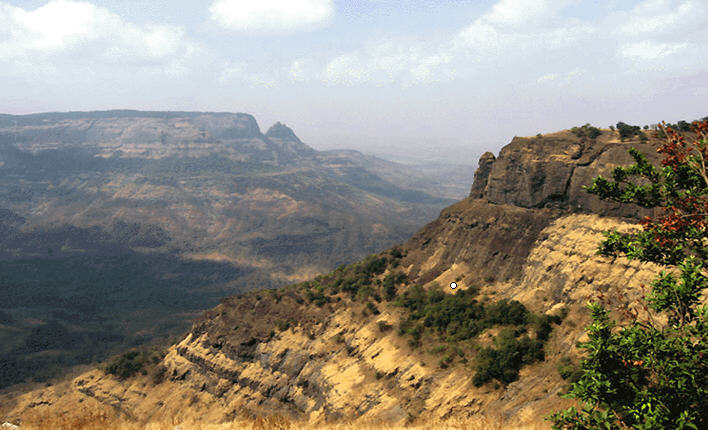
Brahma Giri Nashik
